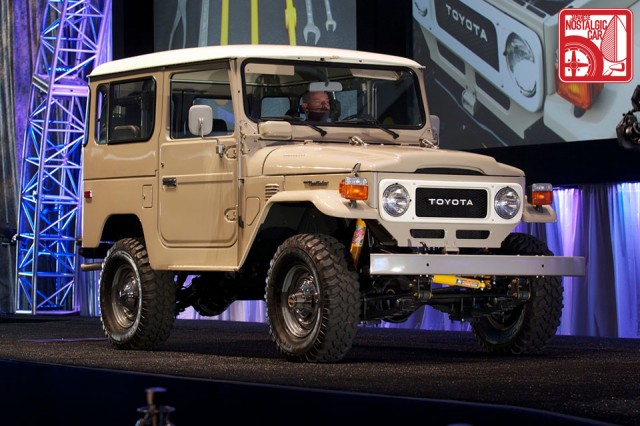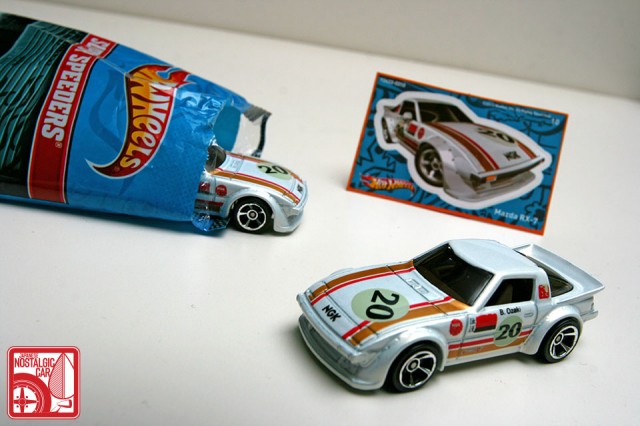
Today is Earth Day, and JNCs have always been at the forefront of environmentally friendly motoring. If it wasn’t for the Oil Crisis of 1973, JNCs may not have even entered the mainstream automotive world. From kei cars to hybrids there have been many economical cars from Japan.
What’s the most environmentally friendly JNC?
Our pick is an obvious one — the Honda CRX HF. In 1985 the HF, which stood for “High Fuel economy,” was highway rated at a whopping 57 miles per gallon. What’s more, it had all the handling prowess and fun-to-drive quotient of its more powerful brethren. Eat your hybrid heart out, Prius!
What say you, dear reader? As always, the most entertaining or inspiring comment by next Monday will receive a toy. Click through to see the winner from last week’s question, “What’s the best Japanese nostalgic SUV?“

This week’s winner was pstar with his comment about the ol’ Land Cruiser.
… this week’s Q is obviously the FJ40. This is like asking “What’s the best rear-engined German sportscar?” Yeah, you can find contrarians, but still… even they don’t buy their own argument. Come on.
Omedetou! Your comment has earned you a rare Hot Wheels Super Speeders mystery pack Mazda RX-7!







sure name the obvious honda! thanks jnc for once again stating the obvious in your question JNC. i dont blame you people or hate, (lol no hate here) my choice goes out out the first gen suzuki cultis or swift or chevy sprint metro pontiac firefly whatever. GM did a bunch of these lil’ hamsters with every of their sauce(pontiac,geo,chevy suzuki, i think thats it!)when my mom divorced my he was dirt poor(sad but true)so the first car he bought after the divorce was an 88 GM whatever it was, it was a poor man’s car back in 1997. the car was a love hate relationship for me and my dad for the next 5 years, until the trany got all broken and stuff and the engine overheated and bla bla bla the car was no good no more. we were sad to see that poor lil hamster go. we loved the fact i wasnt a gas guzzler and a pretty easy car for me to learn how to drive stickshift. so thats pretty much it, that lil gm thing wich inst really a JNC when you think about it but its still a suzuki underneath it all,
we from Québec so we hope not to see suzuki cars go like our cousins did in south of the border.
My pick is the First Generation Honda Civic CVCC.
A car, built throughout most of the 70’s, was revolutionary in engine design. The Compound Vortex Controlled Combustion Engine (CVCC) was debuted in 1975, using modern technology eliminating harmful emissions which almost all other cars were emitting. When the american government decided to stop these emissions in all cars by forcing manufacturers to fit catalytic converters and use unleaded petrol, the Civic’s CVCC design produced so little emissions that it was exempt. It also used under 6l/100km of petrol. Today, this is still an impressive figure for fuel economy.
It was a car far further ahead of its time than any other american car made with it in the 70’s that created a firm base for Honda to build on for the next 40 years.
A 1982 Toyota Tercel. (4 spd manual).
(In metallic brown).
Also known (to my friends) as the 0-60 in 15 minutes rally car.
Once again, it’s hard to argue with your choice. But there’s another reason the CRX HF is probably the most eco-friendly JNC: They reliably run for what seems like forever.
So if you factor in the consumption of resources needed to build any car in the first place, plus the disposal and recycling of its components at the end of its service life, a durable car provides multiple benefits. First, it makes the most of the energy and materials used to create it — by performing well through a long lifespan, and staying out of the junkyard. But on top of that, it also saves the resources that would have been used to manufacture another car to replace it, had it not endured so well.
Combine this with its compact size and exceptional fuel economy, and it’s hard to imagine a more environmentally friendly JNC.
Last I remember the guy I sold the Tercel to was still using it in 2000 or 2001.
(When I last saw it being driven).
So yeah, the longevity and reliability is important also
Don’t forget the bodies of all old Hondas are biodegradable! Even now, most cars can’t match that sort of back-to-the-Earth commitment to sustainability.
If you mean rust, well, sadly that’s often true. But the front fenders, bumper covers and lower-body cladding on a 1G CRX are all one form of plastic or another, so at best they’re recyclable. But at least these parts are really durable, too, which beats being in a hurry to biodegrade in my book! 🙂
Yes, rust of course. It’s possible, but I doubt the bumper material is recyclable. Iron oxide will return to the earth rather quickly; plastic sticks around practically forever.
..except those plastic parts didn’t hold up too well either. The front header panel and front fenders have a nasty tendency to crack and fall apart. Finding a 1g CRX with uncracked plastic is rare. As for recyclable….is that type of plastic recyclable?
I’d say something more like the 2000GT. They only made ~350 of them, and most of them wouldn’t have too many miles on them.
If you think of the thousands of people that get to appreciate the few cars, and the impact such a small amount of them made, I think they’d be on top!
This civic here. He seems real tight with nature. Best buds.
http://www.nationalgeographicstock.com/comp/MM6/842/956203.jpg
There’s not many (if any at all) full size JNCs that get greater than 57 mpg. There are quite a few 360cc kei cars on the other hand that get greater than 57 mpg.
Mitsubishi 360 – 25 km/l -> 58.8 mpg
http://www.asahi-net.or.jp/~rf7k-inue/izen/no-14/lt-20/lt-siyo.html
Honda Life 360 – 28 km/l -> 65.8 mpg
http://www.honda.co.jp/auto-archive/life/2door-others/touring1974/sl_sy.html
Honda N360 – 28 km/l -> 65.8 mpg
http://www.honda.co.jp/auto-archive/n360/1968/n360_sy.html
Subaru 360 – 28 km/l -> 65.8 mpg
http://www.asahi-net.or.jp/~rf7k-inue/izen/no-3/subaru/su-siyo.html
Suzuki Fronte Coupe – 29 km/l -> 68.2 mpg
http://www.geocities.jp/onlyjustfadeaway/cxgf-2.jpg
That’s not to say that there aren’t some impressive full size JNCs out there as well.
Honda S800 – 18 km/l -> 42.3 mpg
http://www.honda.co.jp/auto-archive/s800/1968/coupe_sy.html
Honda Civic 1st gen. – 22 km/l -> 51.7 mpg
http://blog-imgs-36.fc2.com/a/h/5/ah5243/20100124164538a00.jpg
Toyota Corolla TE20 – 21 km/l -> 49.3 mpg
http://blog-imgs-27.fc2.com/a/h/5/ah5243/200910120702569bb.jpg
Toyota Celica TA20 – 20 km/l -> 47.0 mpg
http://blog-imgs-27.fc2.com/a/h/5/ah5243/200910232028152aa.jpg
Toyota Publica KP30 – 21 km/l -> 49.3 mpg
http://blog-imgs-45.fc2.com/a/h/5/ah5243/20110522170124054.jpg
Toyota Publica KP50 – 22 km/l -> 51.7 mpg
http://blog-imgs-45.fc2.com/a/h/5/ah5243/201105221655208d5.jpg
Some manufacturers were really terrible about listing there fuel economy in their spec sheets (I’m looking at you Nissan and Isuzu), so it’s hard to say how well the old Bluebirds and Belletts would have done. Given the info I could find though, I’d say the winners are the Suzuki Fronte Coupe at a stratospheric 68.2 mpg and the first gen Civic at a wicked 51.7 mpg.
It may be also worthwhile to note that manufacturers essentially set their own testing protocols for a very long time, so what they said was 50mpg may have been 45 or lower. The HMV Freeway was touted to achieve 100mpg, but you had to drive 30mph or something similar to make that happen. I’m not saying it’s not possible to hit those numbers; it most certainly is. However, choosing a winner based on various 40 year old adverts may not be the most exact way to do things. 😉
Any JNC still running on the road is an environmentally friendly car.
Sure they might leak fluids now, the MPG is tricky at best, and you spend money on chemicals, paint & consumables to maintain/fix it. But compared to say, a new Camry or Civic, the older car is not laden with chemical laced carcinogenic electronics, inhalant abusive “new car smell,” enough plastic cladding to outfit a battalion of Imperial Stormtroopers, wasteful practice of forced dealership servicing, and the time and effort it took to manufacture and transport the car to the final destination. Parts can come from recycled or salvaged sources, which is also a major plus vs. the technologically wasteful junk stuffed into new cars where you have to buy OEM or suffer where they have to be manufactured and shipped to parts warehouses all over the world.
(mid way down)
http://www.autolifers.com/garage-life-tec-arts-tuning-shop-japan/
Tec-Arts AE86. Still powered by 4age, getting 40mpg.
” This is the Tec-Art’s ‘ECO Version’ AE86. Running a fully rebuilt stock 4AGE, injectors and mild Tuning make it fresh and fun to drive. The real magic comes from Kamata-San’s incredible ECU mapping work. This AE86 is very economically mapped for everyday use on Motec Management, allowing up to 40 mpg on a long drive. ”
probably not -the- best. but still pretty cool. there was a post more on it over on club4ag, but got wiped with the crash ._.
I would say that the fb rx7 is probably the most environmentally friendly JNC on the road. Because most of them that are parked on the road likely do not run. I have one and am an avid rx7 fan. But honestly, i know more people with these cars that do not run than people that drive them. Come to think of it…no one i know with one drives it. Because it doesnt run. So with the amount of alge and moss growing on these cars sitting in front of peoples houses and in their back yards, its very likely that they are filtering more air than they are poluting.
Again no offense to the rx7 i love them. I have an fb and an fd and i love the rotary. But after so many years of sitting the coolant seals harden up and the chrome comes off of the rotor housings which are no longer made for the 12a. That all adds up to a lot of sitting fb’s.
the most environmentally friendly JNC would be a peripheral port 13B rx7 running a straight pipe from the collector. sucking down fossil fuel and dino oil and releasing all kinds of hydrocarbons and noxious gasses into the atmosphere, MAYBE making an appreciable dent in all of the non-auto related pollution, widening the hole in the ozone layer to speed up global warming. killing small animals within a 5 mile radius from the noise level at idle, shredding tires and brake pads and leaving a thick layer of soot and dust everywhere it goes. no passenger seat so it’s as inefficient as possible. IMSA body and big whale tail for lots of
dragdownforce. speaking of whales, “nuke the whales” sticker for maximum effect.why is this the most environmentally friendly car? the mass-pollution and obnoxious pitch and volume of the engine will drive people away lessening their impact on the immediate area. it will consume natural resources at least triple the rate of your average commuter, pushing us further down the post-peak oil slope and forcing reliance on alternative powered vehicles. the sight/sound of it rapidly filling a commuter’s rearview should be enough to scare them into bicycling or mass transit. i estimate that the 99% of the population that can’t appreciate this car don’t belong on the road anyway.
after all, cars don’t pollute the earth. people do.
“cars don’t pollute the earth. people do”
-Very well said sir.